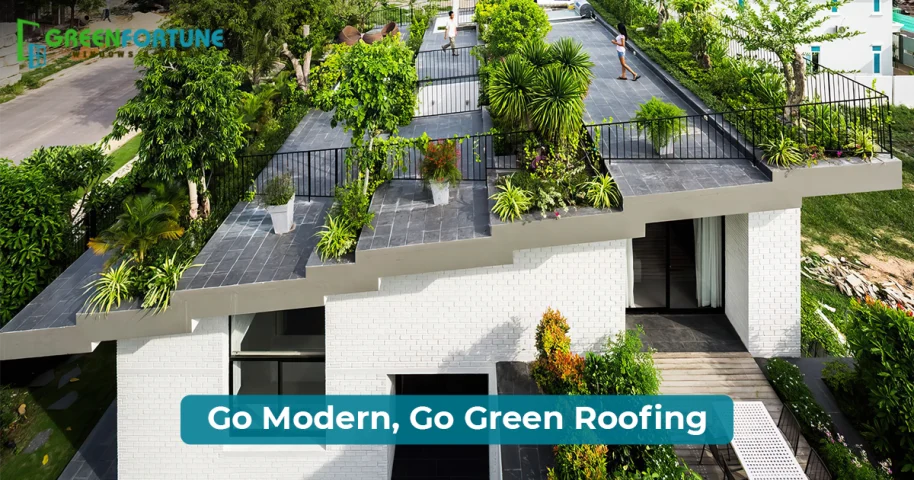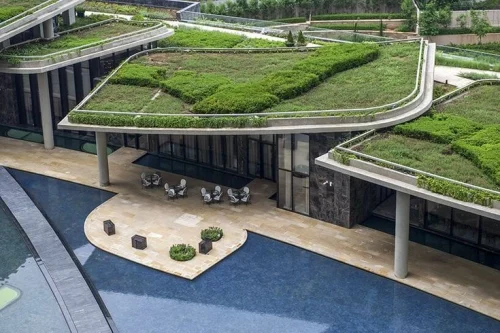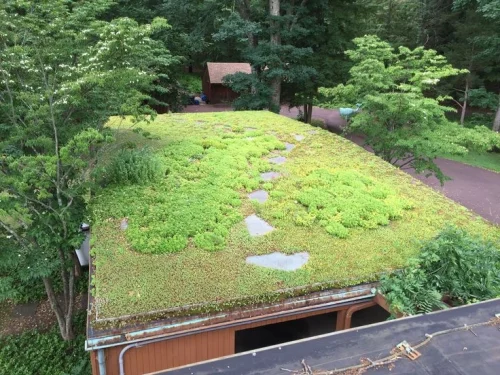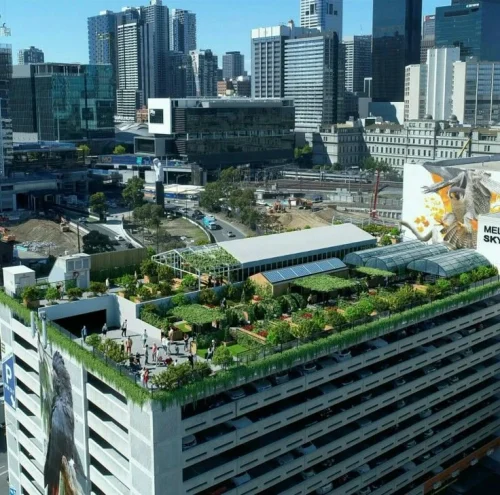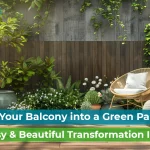
Balcony Garden Ideas: Turn Your Space into a Relaxing Green Retreat
June 17, 2025
Indian Door Design Ideas That Blend Tradition and Style for Modern Homes
June 17, 2025Table of contents
- What Is Green Roofing?
- Top Green Roofing Benefits
- 1. Keeps Your Home Cooler (And Saves Energy)
- 2. Reduces the Urban Heat Island Effect
- 3. Improves Air Quality
- 4. Manages Rainwater and Reduces Flooding
- 6. Increases Property Value
- 5. Adds Extra Outdoor Space
- 7. Supports Urban Biodiversity
- 8. Extends the Life of Your Roof
- 9. Cuts Down on Noise
- 10. Encourages Sustainable Living
- Is Green Roofing Right for You?
- Ready to upgrade your windows and doors?
- FAQs
When you think of a rooftop in a city, what usually comes to mind? Probably something gray, flat, and maybe covered with HVAC units or water tanks. But more and more people are changing that by turning their roofs green.
Green roofing is catching on in cities all over the world. It’s not just about making your home look nice from above (though it does that too). It’s about saving energy, helping the environment, and even adding more living space.
In this blog, we’ll break down exactly why green roofing is a smart choice for urban homes and buildings, and how it can make a real difference in your day-to-day life — and in your city as a whole.
What Is Green Roofing?
Let’s start simple. A green roof (also called a living roof) is a roof that’s partially or completely covered with vegetation. This could be grass, plants, flowers, shrubs, or even small trees, depending on the structure.
Green roofing systems usually include:
- A waterproof layer
- Drainage and root barriers
- Soil or a growing medium
- Vegetation
Some people install green roofing for beauty. Others do it for the environmental benefits. But most do it for both.
Top Green Roofing Benefits
Let’s dive into the main advantages of adding a green roof to your urban home or building.
1. Keeps Your Home Cooler (And Saves Energy)
In cities, buildings soak up a lot of heat. Dark rooftops get especially hot under the sun. This makes your home warmer and your air conditioner work overtime.
But green roofing acts like insulation. The plants absorb heat, and the soil adds an extra layer that keeps your building cooler. In winter, it also helps keep the warmth in.
Result? Lower energy bills and a more comfortable living space all year round.
2. Reduces the Urban Heat Island Effect
Ever noticed how much hotter cities feel compared to the countryside? That’s called the urban heat island effect. All that concrete and asphalt traps heat, raising temperatures in urban areas.
Green roofing can help cool things down. Even a small patch of greenery can make a difference. When more buildings add green roofs, the whole neighborhood benefits.
3. Improves Air Quality
Plants naturally filter the air. They absorb carbon dioxide and release oxygen. On a green roof, this means cleaner, fresher air around your home.
They also trap dust and pollutants, especially useful in cities with heavy traffic and industry. Think of green roofing as a little air purifier sitting on top of your home.
4. Manages Rainwater and Reduces Flooding
One of the less talked-about but super important living roof advantages is how it handles rain. In cities, rainwater often rushes down hard surfaces, flooding streets and overwhelming drainage systems.
A green roof absorbs a big chunk of that water. The soil and plants slow it down, store some, and release the rest slowly. This helps reduce pressure on city drains and lowers the risk of floods.
6. Increases Property Value
It’s no surprise that eco-friendly roofing features make homes more attractive to buyers. Green roofs are beautiful, energy-efficient, and environmentally responsible — all things that add value.
Plus, if you’re in a city that offers incentives or tax breaks for green roofing (many do), it
5. Adds Extra Outdoor Space
Need more room to relax? A green roof can turn a boring, unused surface into a small garden, lounge area, or even a vegetable patch.
In cities where outdoor space is limited, this is a huge bonus. You can grow herbs, enjoy sunsets, or just unwind with a cup of coffee — right on your roof.
7. Supports Urban Biodiversity
Birds, bees, butterflies — they’re often pushed out of cities due to a lack of green space. But green roofing brings back that natural habitat.
Adding plants to your roof gives insects and birds a place to rest, feed, or even nest. Over time, this helps increase urban biodiversity, which is good for both the environment and our well-being.
8. Extends the Life of Your Roof
Believe it or not, covering your roof with soil and plants can actually make it last longer. How?
Green roofing protects the materials underneath from harsh weather, UV rays, and temperature changes. That means less cracking, drying, or damage, and fewer repairs or replacements over time.
9. Cuts Down on Noise
Cities are loud. Traffic, horns, construction — it never ends. But green roofing acts as a natural sound barrier.
The combination of soil and plants can reduce outside noise by several decibels, especially if you live under a flight path or near a busy road. You’ll notice the difference inside, especially in top-floor rooms.
10. Encourages Sustainable Living
Finally, green roofs are part of a bigger shift toward sustainability. If you care about the planet, green roofing is one practical step you can take — right at home.
You don’t need a big space or budget to start. Even a small section of your roof can be turned green. And every little bit helps the planet breathe a little easier.
Is Green Roofing Right for You?
Now, green roofs aren’t one-size-fits-all. You’ll need to consider:
- Your roof’s structure: Is it flat or sloped? Can it support extra weight?
- Climate and sunlight: Certain plants do better in specific conditions.
- Budget: Initial costs are higher than regular roofing, but the long-term savings are real.
- Maintenance: Some green roofs need minimal care, while others (like rooftop gardens) need regular upkeep.
You can go for an extensive green roof (lightweight, low-maintenance, mostly mosses or grasses) or an intensive one (heavier, more like a full garden). There are also semi-intensive options that fall in between.
Ready to upgrade your windows and doors?
Green Fortune offers high-quality, durable uPVC solutions that are built to last and designed to suit your space. With fast delivery, a 10-year warranty, and clear pricing through the Fair Price Estimator, it’s simple to get exactly what you need, without the wait.
Reach out today and get started with a free consultation.
FAQs
- Is green roofing suitable for all types of urban buildings?
Most urban buildings can support green roofing, but it's important to check if the structure can handle the extra weight. Flat or low-sloped roofs work best. With proper planning and design, both homes and commercial buildings can benefit from this eco-friendly roofing option.
- Can green roofing be installed on sloped roofs?
Yes, green roofing can be installed on sloped roofs, but it requires special design considerations to prevent soil erosion and ensure proper drainage. Systems like modular trays and grid-based supports are often used. The steeper the slope, the more engineering and planning it will need.
- Do green roofs attract pests or insects?
Green roofs can attract some insects, but they’re typically pollinators like bees and butterflies, which help support the local ecosystem. With proper maintenance and plant selection, pest problems are minimal. Many homeowners find that green roofs actually improve the natural balance rather than causing infestations.




